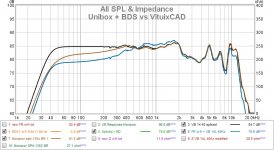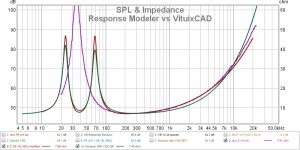Well... at least I manage to do something interesting (bizarre and somehow stimulating 🙂)
Joke apart you open a new complete world to me
Shall do as you suggest as I get time and hopefully shall get there.
Thank you again jReave
Joke apart you open a new complete world to me
Shall do as you suggest as I get time and hopefully shall get there.
Thank you again jReave
Ciao Ciccio
As already said you have to calculate your box size (14 liter tuned at 40Hz is fine) and include baffle step in tour FR to properly design a x-over. There are many tools out there but I prefer to use Vituixcad because all the tools are included in one package; so the steps are:
- design the box and save the frequency (low part or nearfield)/impedance files with the Enclosure tool.
- design the front baffle and position the woofer with the Diffraction tool considering that larger baffle are to be avoided in order to limit the reduction of pressure level at low frequency.
- mix the Low FR (nearfield) prevously saved with the FRD of your speaker by using the merger tool.
- use the main program to design you x-over
Monacor speaker are pretty decent, I have a 5 liter box with a 4-inch woofer (SSP-110)/Audax tweeter - using a first order filter - and I am very satisfied with it, so I played a bit with your speakers by designing a 1st and a 3
rd order x-over. I included a zip file with the frd and zma files, try both and let me know which one is the best.
As already said you have to calculate your box size (14 liter tuned at 40Hz is fine) and include baffle step in tour FR to properly design a x-over. There are many tools out there but I prefer to use Vituixcad because all the tools are included in one package; so the steps are:
- design the box and save the frequency (low part or nearfield)/impedance files with the Enclosure tool.
- design the front baffle and position the woofer with the Diffraction tool considering that larger baffle are to be avoided in order to limit the reduction of pressure level at low frequency.
- mix the Low FR (nearfield) prevously saved with the FRD of your speaker by using the merger tool.
- use the main program to design you x-over
Monacor speaker are pretty decent, I have a 5 liter box with a 4-inch woofer (SSP-110)/Audax tweeter - using a first order filter - and I am very satisfied with it, so I played a bit with your speakers by designing a 1st and a 3
rd order x-over. I included a zip file with the frd and zma files, try both and let me know which one is the best.
Attachments
-
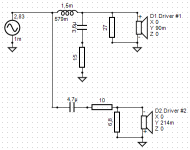 Monacor 13_Tw_1o ordine XO-schema-1.png9.5 KB · Views: 65
Monacor 13_Tw_1o ordine XO-schema-1.png9.5 KB · Views: 65 -
Monacor 13.zip58.2 KB · Views: 46
-
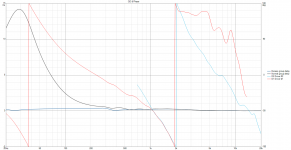 Monacor 13_Tw_3o ordine GD+Phase.png97.4 KB · Views: 51
Monacor 13_Tw_3o ordine GD+Phase.png97.4 KB · Views: 51 -
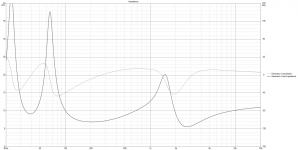 Monacor 13_Tw_3o ordine Impedance.png93.7 KB · Views: 54
Monacor 13_Tw_3o ordine Impedance.png93.7 KB · Views: 54 -
 Monacor 13_Tw_3o ordine SPL.png105 KB · Views: 55
Monacor 13_Tw_3o ordine SPL.png105 KB · Views: 55 -
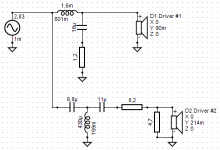 Monacor 13_Tw_3o ordine XO-schema-1.png10.4 KB · Views: 70
Monacor 13_Tw_3o ordine XO-schema-1.png10.4 KB · Views: 70 -
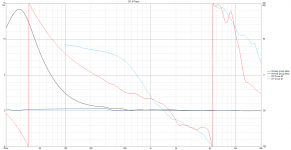 Monacor 13_Tw_1o ordine GD+Phase.png96.8 KB · Views: 66
Monacor 13_Tw_1o ordine GD+Phase.png96.8 KB · Views: 66 -
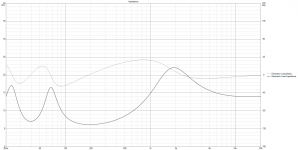 Monacor 13_Tw_1o ordine Impedance.png80.3 KB · Views: 67
Monacor 13_Tw_1o ordine Impedance.png80.3 KB · Views: 67 -
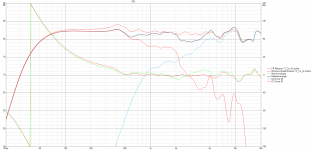 Monacor 13_Tw_1o ordine SPL.png120.9 KB · Views: 64
Monacor 13_Tw_1o ordine SPL.png120.9 KB · Views: 64
Ciao shadowplay
This community is great place were beginner like me may found help in their project
I am away from home for work but as i get back i shall try to put in good use all suggestions and things i learned over here
For the moment i can only thank you for the time you spent
and.. yes the Monacor speakers must not be that bad if i manage to make them sounding -)
joke apart i had a very good impression from the component used (considering the price range
Shall update all of you once the project is finalized
This community is great place were beginner like me may found help in their project
I am away from home for work but as i get back i shall try to put in good use all suggestions and things i learned over here
For the moment i can only thank you for the time you spent
and.. yes the Monacor speakers must not be that bad if i manage to make them sounding -)
joke apart i had a very good impression from the component used (considering the price range
Shall update all of you once the project is finalized
Lately I've been interested in the relative validity of some of the different modeling programs and I've only started looking at VituixCAD recently but already I'm noticing some differences between it and other programs.
First pic below is a comparison of the woofer FR from different programs. Black is the traced FR spliced together with Unibox's vented response. Brown is VituixCAD's spliced response (just about the same as Unibox's) plus the cabinet's baffle effects. Blue is Unibox's vented response plus the baffle effects from the Baffle Diffraction and Boundary Simulator. And what we see is a pretty significant difference in terms of the mid peaking and the 6dB of baffle step loss.
Pic 2 shows the woofer impedance. Purple is the traced open air impedance response. Green is the vented box response from VituixCAD and red is the vented response from Response Modeler. The tuning frequency looks to about the same in the 2 programs although the height of the peaks are a little different, but there is also a fairly significant difference right in the midrange where the xo is situated between ~ 600Hz and 6kHz. And this is because in VituixCAD the whole impedance response is a simulation whereas in Response Modeler only the bottom portion of the impedance is simulated for the vented box but the rest of the impedance is matched to the original impedance of the driver. As far as I'm aware, Response Modeler is the only program that can do this for you.
The result of these 2 differences in the FR and the impedance on the xo is quite dramatic - each set of files needs very different xo values to arrive at a good looking response. I can't say with any confidence if 1 is more accurate than the other or if in fact both of them are inaccurate but I will note that 1 of the 1st things I noticed when I downloaded VituixCAD was this quote:
"Also VituixCAD has some tools which are meant for preliminary or simplified theoretical studies, but otherwise they should be avoided. For example graphically traced or downloaded manufacturer's response data is okay for preliminary studies, but not for final crossover design."
Which given the above discrepancies I'm sort of going to take for now to mean that besides the xo module, VituixCAD's simulators, in particular the diffraction and the impedance modeling modules, may not be quite as robust as some of the other tools out there.
Again though, this is just reinforcing the benefit of using the real world in-cabinet measurements to get the xo right.
First pic below is a comparison of the woofer FR from different programs. Black is the traced FR spliced together with Unibox's vented response. Brown is VituixCAD's spliced response (just about the same as Unibox's) plus the cabinet's baffle effects. Blue is Unibox's vented response plus the baffle effects from the Baffle Diffraction and Boundary Simulator. And what we see is a pretty significant difference in terms of the mid peaking and the 6dB of baffle step loss.
Pic 2 shows the woofer impedance. Purple is the traced open air impedance response. Green is the vented box response from VituixCAD and red is the vented response from Response Modeler. The tuning frequency looks to about the same in the 2 programs although the height of the peaks are a little different, but there is also a fairly significant difference right in the midrange where the xo is situated between ~ 600Hz and 6kHz. And this is because in VituixCAD the whole impedance response is a simulation whereas in Response Modeler only the bottom portion of the impedance is simulated for the vented box but the rest of the impedance is matched to the original impedance of the driver. As far as I'm aware, Response Modeler is the only program that can do this for you.
The result of these 2 differences in the FR and the impedance on the xo is quite dramatic - each set of files needs very different xo values to arrive at a good looking response. I can't say with any confidence if 1 is more accurate than the other or if in fact both of them are inaccurate but I will note that 1 of the 1st things I noticed when I downloaded VituixCAD was this quote:
"Also VituixCAD has some tools which are meant for preliminary or simplified theoretical studies, but otherwise they should be avoided. For example graphically traced or downloaded manufacturer's response data is okay for preliminary studies, but not for final crossover design."
Which given the above discrepancies I'm sort of going to take for now to mean that besides the xo module, VituixCAD's simulators, in particular the diffraction and the impedance modeling modules, may not be quite as robust as some of the other tools out there.
Again though, this is just reinforcing the benefit of using the real world in-cabinet measurements to get the xo right.
